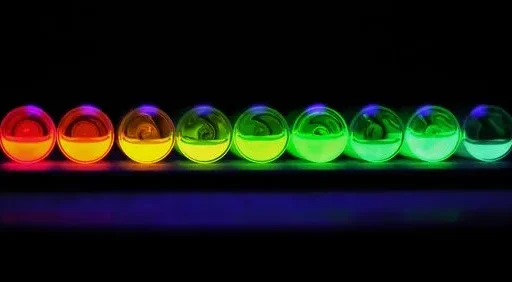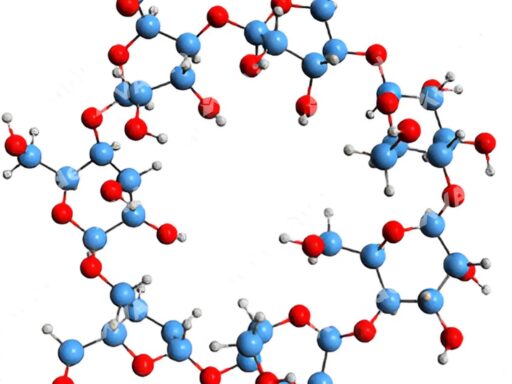Table of Contents
Overview of Polymorphism of Pyrene:
Pyrene, a renowned polycyclic aromatic hydrocarbon (PAH), has attracted the attention of researchers for many years because of its distinctive structural, optical, and electrical characteristics. This substance’s rigid and extremely planar molecular structure makes it an intriguing subject for investigation, particularly in the field of materials science. Pyrene’s response to harsh circumstances, such as high pressure, is an essential study focus. Under such circumstances, materials frequently demonstrate polymorphism, the phenomenon in which a compound assumes various crystalline forms based on the external variables, such as temperature or pressure.
Studies conducted under high pressure offer critical insights into the molecular-level transformations of materials when exposed to forces far greater than those they would encounter in typical air settings. The current study aims to look into what happens to pyrene when it is compressed up to 35 GPa using a diamond anvil cell (DAC), which is a very good tool for creating such high pressures. Through the analysis of pyrene’s polymorphism in these highly challenging circumstances, we can explore novel opportunities for its utilization in several domains, including materials science and environmental technology.
A Comprehensive Polymorphism of Pyrene: Structure, Properties, and Applications
Pyrene (C₁₳H₁₀) is a simple but structurally important polycyclic aromatic hydrocarbon (PAH). It is made up of four stacked benzene rings that are fused together. The arrangement of this structure imparts pyrene with several unique physical and chemical characteristics. One notable characteristic of this substance is its fluorescence, which makes it a valuable asset in fluorescence-based sensing applications. Furthermore, pyrene’s high electron density and prolonged conjugation allow it to engage with light in ways that are advantageous for organic electronics, namely in the advancement of organic light-emitting diodes (OLEDs).
Furthermore, pyrene is renowned for its ecological importance. As a result of incomplete combustion of organic substances, such as fossil fuels or biomass, it is frequently present in the environment. Given its contribution to environmental degradation and its application in scientific study, pyrene is a topic of continuous interest in both applied and basic studies. Crystal structures of pyrene polymorphs are viewed along the a-axis.

Polymorphism: An Important Concept in Material Science
Polymorphism is the capacity of a substance to exist in several crystalline forms, each exhibiting distinct physical or chemical characteristics. In the study of organic materials, polymorphic transitions are very important because they can change the properties of materials, such as how well they dissolve, how stable they are, and how reactive they are. The investigation of polymorphism is critical for understanding the use of materials in different applications, as different polymorphs of the same substance can display entirely distinct behaviors in certain instances.
When exposed to various situations, such as high pressure, organic compounds like pyrene undergo polymorphic transformations that offer new opportunities to investigate potential adjustments to their characteristics for specific applications. The scientific investigation of polymorphism allows researchers to better understand the relationship between molecular structure and material characteristics.
This paper provides a rationale for investigating the polymorphism of pyrene under high pressure:
The Polymorphism of Pyrene, similar to other organic compounds, is rather high under typical atmospheric circumstances. Nonetheless, under intense pressure, its molecular structure can undergo significant changes. The transformations, referred to as polymorphic transitions, are of significant interest to scientists due to their potential to reveal novel phases of the material that may possess valuable characteristics.
An investigation of the Polymorphism of Pyrene under high pressure is part of a larger endeavor to understand the behavior of organic substances in extreme conditions. Studies of this nature can provide a valuable understanding of the underlying physics and chemistry principles involved in molecular interactions. lectrical, optical, or mechanical properties, which could lead to exciting new technological advances. understanding of the underlying principles of physics and chemistry involved in molecular interactions. Additionally, they can contribute to the advancement of novel materials suitable for high-performance applications. Furthermore, the investigation of polymorphism of Pyrene response to compression can uncover novel phases that may demonstrate distinct electrical, optical, or mechanical characteristics, therefore creating promising opportunities for technological advancement.
Compressional behavior of the polymorphs of pyrene up to 35.5 GPa.
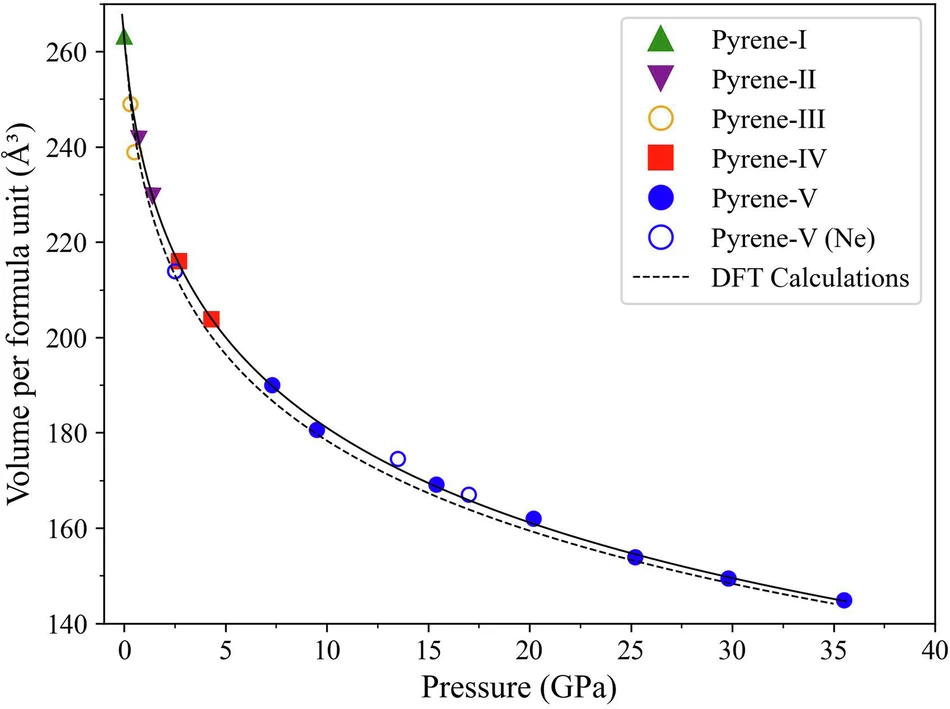
An Overview of High-Pressure Research Utilizing a Diamond Anvil Cell (DAC):
A fundamental instrument for laboratory investigations of high-pressure materials is the diamond anvil cell (DAC). A Diamond Compression Analyzer (DAC) is a device that employs two opposing diamonds to subject a small sample to pressures that may surpass those encountered in the Earth’s mantle. Diamonds, with their exceptional hardness, can endure these tremendous pressures while also allowing light and X-rays to pass through the sample for observation and measurement.
The Digital Audio Converter (DAC) has transformed high-pressure research by allowing scientists to investigate the behavior of materials under previously unachievable circumstances. We can carefully study the Polymorphism of Pyrene structural alterations at pressures up to and beyond 35 GPa via compression in a DAC, a range where we anticipate substantial polymorphism changes.
An Experimental Configuration for Compressing Polymorphism of Pyrene to 35 GPa:
We position the Polymorphism of Pyrene sample between the two diamond anvils in the DAC to investigate the alteration of pyrene’s structure under intense pressure. Proper preparation of the sample, which is usually a tiny crystal or powder, is essential to provide precise and dependable results. Once we position the pyrene between the diamonds, we gradually apply pressure using either tightening screws or a hydraulic press.
The experiment uses various methodologies to observe the structural modifications that occur with increasing pressure. Two often employed techniques are Raman spectroscopy and X-ray diffraction. Raman spectroscopy enables scientists to quantify the vibrational modes of pyrene molecules, providing valuable information on changes in bonding and molecular organization. In contrast, X-ray diffraction offers direct insights into the crystal structure of pyrene, enabling scientists to discern the displacement of atomic locations in response to pressure. The enthalpy difference (ΔH) calculated for the four polymorphs (pyrene-II, pyrene-III, pyrene-IV, and pyrene-V) relative to pyrene-I as a function of pressure.
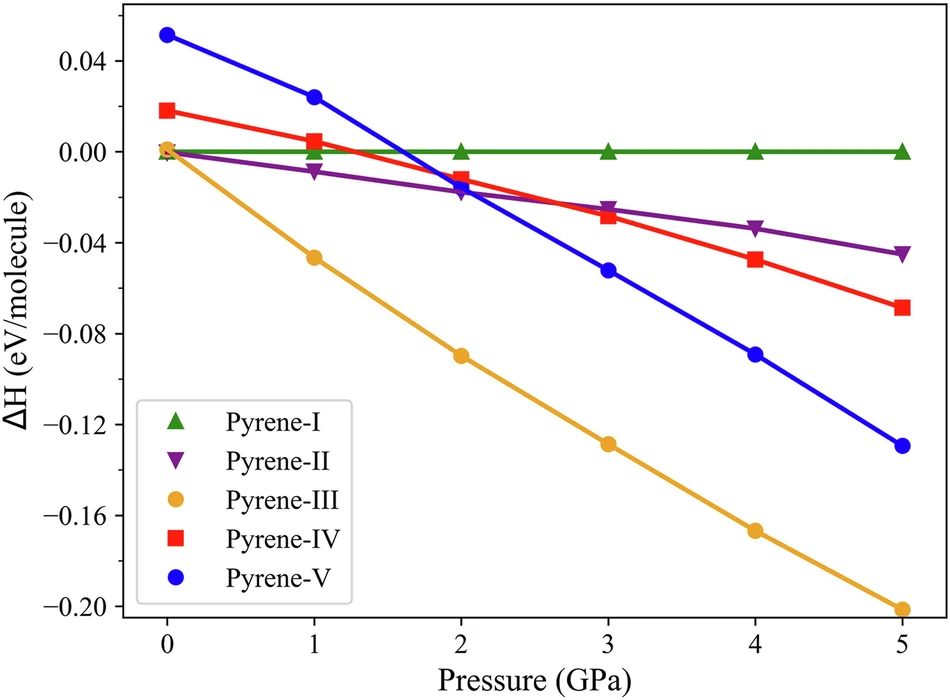
An Analysis of Pyrene’s Behavior in Ambient Conditions:
Prior to compression, pyrene is present in a crystalline state characterized by a highly defined molecular structure. The aromatic rings interact to organize the molecules into a planar, layered structure. The structure of pyrene is responsible for its distinctive physical features, including its comparatively elevated melting point and ability to emit fluorescence when exposed to ultraviolet radiation.
Prior investigations on pyrene have demonstrated that its structure remains uniform in normal environmental settings, with no notable alterations in its molecular configuration unless exposed to external factors such as pressure or temperature. The inherent stability of pyrene makes it a highly suitable option for investigations under high pressure conditions because it enables researchers to directly see the structural changes that occur by compression.
An Analysis of the Structural Alterations in Polymorphism of Pyrene Under Compression:
When pressure is applied to the Polymorphism of Pyrene in the DAC, a transformation in its molecular structure begins. The modifications are induced by the gradual increase in force applied to the molecules, leading to their displacement and rearrangement in an attempt to minimize their energy. At first, the modifications are somewhat minor, including incremental adaptations in the molecular arrangement. Nevertheless, with the rise in pressure, more substantial changes take place.
Under specific critical pressures, pyrene experiences polymorphic transitions, in which its molecules reorganize into completely novel crystal forms. Alterations in the material’s physical characteristics, such as its optical or electrical behavior, frequently follow these transitions. By meticulous observation of these transitions, scientists can get a vital understanding of how pressure affects the behavior of organic molecules. Visualization of intermolecular distances and interplanar angles in the structures of pyrene polymorphs.
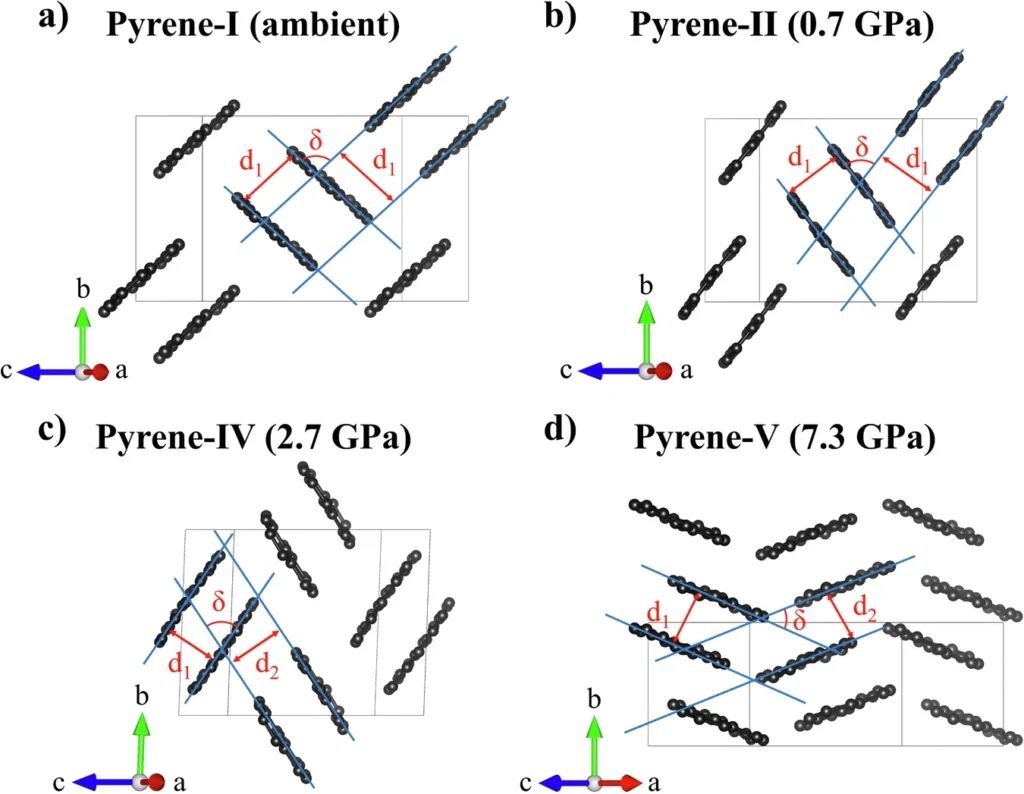
Analysis of Polymorphism of Pyrene at High Pressure:
An important discovery from high-pressure investigations of polymorphism of Pyrene is the distinction of several polymorphic phases when the pressure rises to 35 GPa. Each of these phases corresponds to a unique molecular configuration, characterized by varying packing and chemical bonding among the pyrene molecules.
Under reduced pressures, the Polymorphism of Pyrene retains its initial crystalline crystal structure, with only slight modifications in the arrangement of molecules. Nevertheless, when the pressure reaches 10-15 GPa, the initial significant polymorphic change takes place. At this stage, the Polymorphism of Pyrene molecules undergoes a transition to a more densely arranged arrangement, resulting in a decrease in the intermolecular distance and a change in the crystal’s overall symmetry.
As the pressure continues to rise, we detect further transitions. By the time the pressure reaches 35 GPa, the Polymorphism of Pyrene has seen multiple discrete polymorphic changes, each leading to the formation of a new phase with distinct structural properties. These transitions are typically reversible, meaning that the material can return to its initial structure upon pressure relief. However, in some cases, certain polymorphic phases might demonstrate metastability, persisting even after a gradual decrease in pressure.
Analyzing the Pressure Range: The Importance of 35 Gigapascals of Pressure
Researching the Polymorphism of Pyrene up to 35 GPa is not a random decision. This pressure range is significant because it represents the critical threshold at which some materials experience major alterations in their molecular structure. Polymorphism of Pyrene has a critical threshold of 35 GPa at which several polymorphic transitions happen. This lets researchers study how the material reacts to severe compression and how its behavior changes as a result.
When subjected to pressures nearing 35 GPa, materials frequently display characteristics not observed under normal conditions. For example, they may undergo an increase in conductivity, display distinct visual features, or acquire novel mechanical properties. Through the investigation of pyrene under this pressure, scientists can get significant knowledge about the behavior of organic molecules in highly challenging conditions and the manipulation of their characteristics by compression. Scatter plot of the maximum surface height difference and crystal structures of pyrene-IV at 4.3 GPa and pyrene-V at 35.5 GPa.
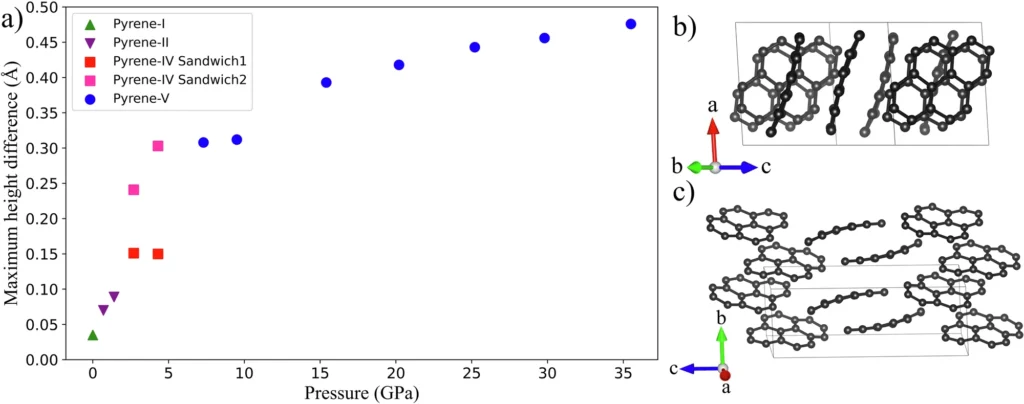
Methods for Analyzing Polymorphism of Pyrene Compression Experiments:
For comprehensive understanding of the material changes in high-pressure studies, it is crucial to employ a variety of analytical methods. Raman spectroscopy and X-ray diffraction are two fundamental techniques for studying pyrene.
Raman Spectroscopy: Raman spectroscopy involves applying a laser beam to the sample and measuring the light that the molecules scatter. The Raman spectrum obtained provides information on the molecules’ vibrational modes, which may vary as the molecular structure undergoes pressure-induced changes. Through the analysis of these alterations, scientists can pinpoint certain polymorphic transitions and acquire an understanding of the characteristics of the newly formed phases under high-pressure conditions.
X-ray Diffraction (XRD): The methodology of X-ray Diffraction (XRD) quantifies the diffraction of X-rays by the constituent atoms within the sample to determine the crystal structure of a substance. Pyrene undergoes alterations in its crystal structure upon compression, which the XRD pattern records. Through the comparison of diffraction patterns at various pressures, scientists are able to delineate the structural modifications that take place and locate the distinct polymorphic phases that develop during compression.
The combination of Raman spectroscopy and X-ray diffraction provides a thorough understanding of the evolving molecular structure of pyrene under high pressure conditions. Raman spectroscopy and XRD synergistically complement each other by providing information on chemical bonding and direct insights into the atomic arrangement, respectively. Fingerprint plot and Hirshfeld surfaces for pyrene-I at ambient and pyrene-II at 0.7 GPa.

An Investigation into the Influence of Temperature on High-Pressure Polymorphism:
Aside from pressure, temperature can also exert a substantial influence on the behavior of materials. Although pressure is the primary factor influencing pyrene polymorphism in these tests, temperature can also affect the speed of transitions and the degree of stability of specific polymorphic phases.
Within certain high-pressure experiments, scientists integrate pressure with increased temperatures to investigate the interaction between these two variables. During compression, applying heat to the sample may expedite specific transitions or provide stability to phases that may otherwise exhibit metastability. This methodology, referred to as high-pressure high-temperature (HPHT) experimentation, is especially valuable for investigating materials that display intricate behavior under extreme circumstances.
Future research could explore the influence of temperature on the polymorphic transitions of pyrene during compression. The manipulation of pressure and temperature by researchers has the potential to unveil novel phases or enhance comprehension of the current polymorphs. Fingerprint plot and Hirshfeld surfaces for pyrene-IV at 2.7 GPa.
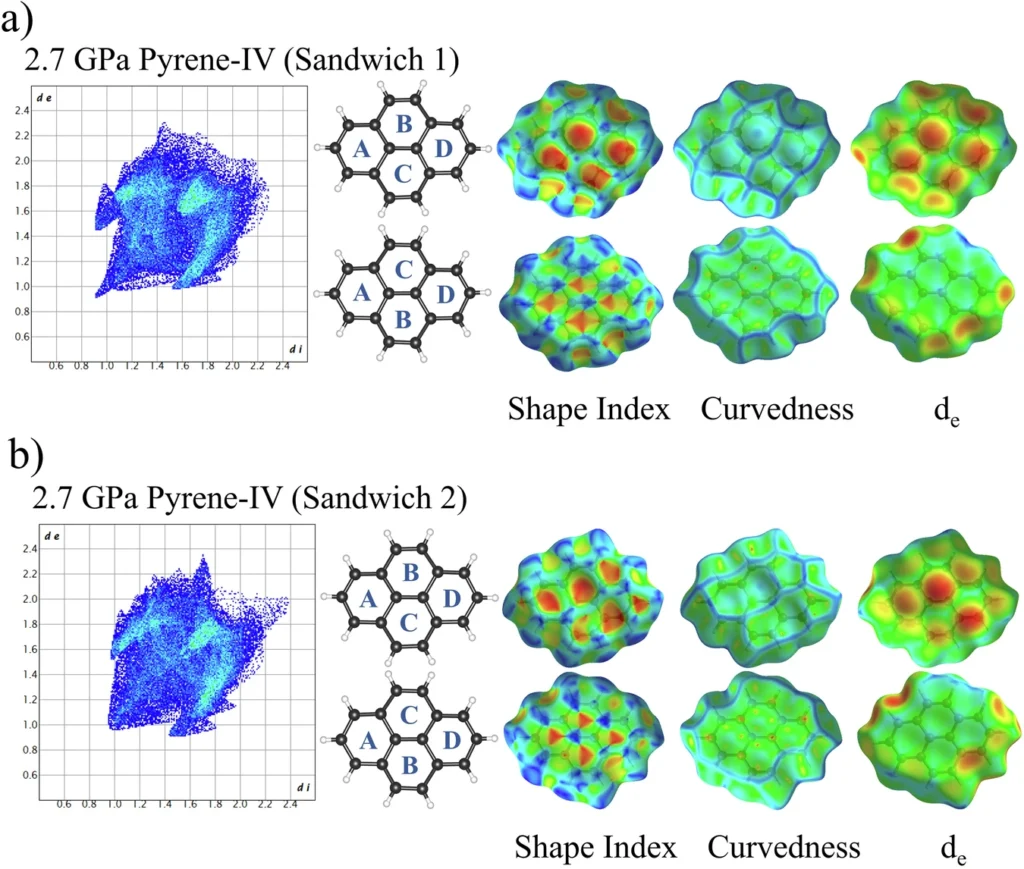
A Comparative Analysis of Polymorphism of Pyrene Molecular Behavior with Other Organic Constituents:
Pyrene is among the chemical compounds that demonstrate polymorphism when subjected to high pressure. Various polycyclic aromatic hydrocarbons (PAHs), including anthracene and tetracene, also experience structural changes when exposed to compression. Scientists can discern recurring patterns in organic molecules’ response to pressure by comparing pyrene’s behavior with that of the related chemicals.
For instance, several polycyclic aromatic hydrocarbons (PAHs) display comparable stacking configurations as a result of the π-π interactions among their aromatic rings. When compressed, these interactions intensify, resulting in a more compact arrangement and the creation of novel polymorphic phases. Nevertheless, the precise characteristics of these transitions can differ based on the dimensions and configuration of the organic compound. By examining pyrene in conjunction with other polycyclic aromatic hydrocarbons (PAHs), scientists can gain a more comprehensive knowledge of how molecular structure affects polymorphism under conditions of high pressure.
Possible applications of Polymorphism of Pyrene:
Under high pressure, the identification of novel polymorphic phases of pyrene presents promising opportunities for its use in many application domains. Certain novel phases may demonstrate improved electrical or optical characteristics, rendering them valuable for usage in organic electronics, such as organic light-emitting diodes (OLEDs) or organic semiconductors.
Furthermore, the various pyrene modifications may have practical applications in environmental science. Polymorphism of Pyrene fluorescence properties has already made it a valuable probe in environmental sensing. The identification of novel phases with distinct optical characteristics has the potential to enhance sensors’ detection of pollutants or other dangerous compounds.
In the field of materials research, the high-pressure polymorphs of pyrene hold promise for the creation of innovative materials with unique mechanical properties. For instance, certain polymorphs may exhibit more rigidity or flexibility compared to the original crystalline structure, therefore rendering them desirable for particular industrial uses. Fingerprint plot and Hirshfeld surfaces for pyrene-V at 7.3 GPa and 35.5 GPa
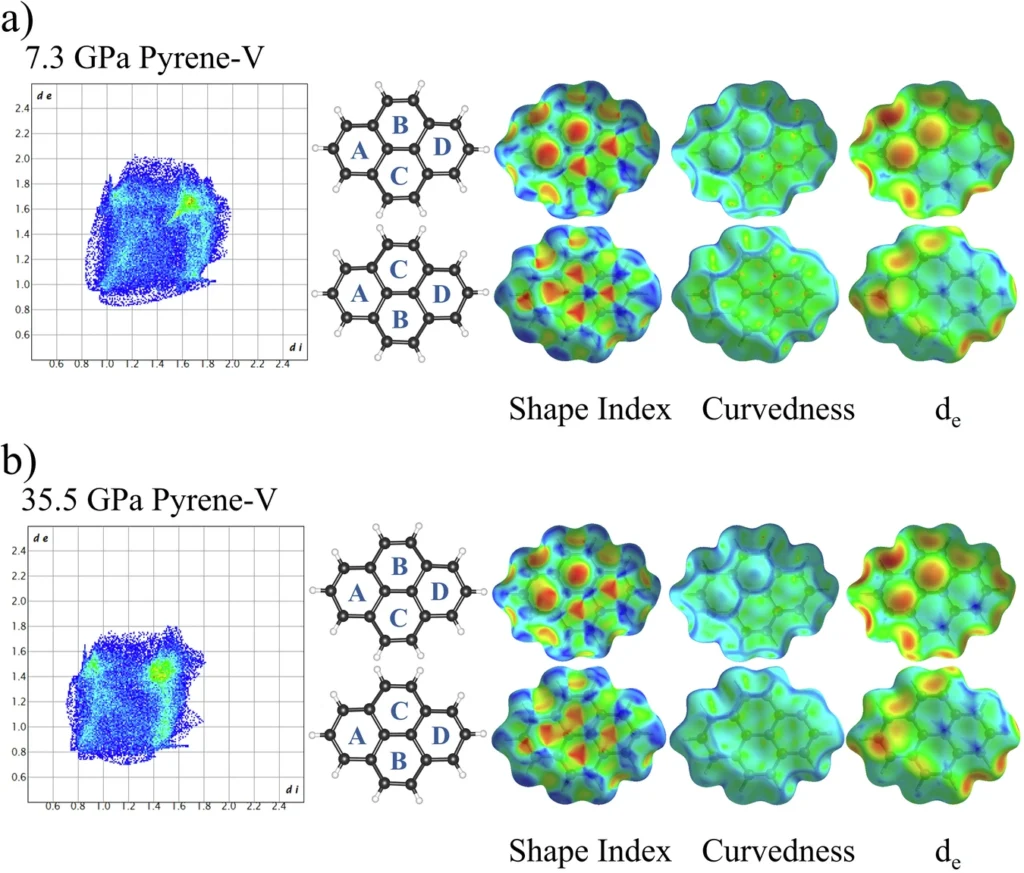
The investigation of high-pressure Polymorphism of Pyrene presents challenges and constraints:
Although the investigation of Polymorphism of Pyrene under high pressure has provided useful knowledge, it is not devoid of difficulties. An inherent challenge in high-pressure research is the limited sample size employed in DAC simulations. The confinement of the sample between the two diamond anvils generally limits its size to a few microns, posing challenges in precisely measuring and observing the material’s behavior.
Furthermore, the high pressures involved can give rise to inherent experimental errors. For instance, the diamonds themselves may occasionally disrupt the observations, particularly in Raman spectroscopy, when their signal superimposes with the sample’s signal. In order to guarantee precise results, researchers must meticulously calibrate their instruments and consider these possible causes of inaccuracy.
Another inherent difficulty is the polymorphic transitions’ reversibility. While most pyrene transitions are reversible, meaning the material returns to its initial structure upon pressure relief, some may display metastability. This phenomenon implies that the material maintains a distinct phase even after reducing pressure, adding complexity to the interpretation of the obtained results.
Key Areas for Future Research in Pyrene Polymorphism:
A preliminary investigation into pyrene polymorphism at 35 GPa is underway. Subsequent investigations may test even higher pressures to determine if more polymorphic shifts occur beyond this barrier. Through experimentally exploring the boundaries of existing DAC technology, scientists have the potential to uncover novel phases of pyrene that possess unparalleled characteristics.
Furthermore, future research could explore the impact of dynamically changing temperature in conjunction with pressure. Experimental investigations under high-pressure high-temperature (HPHT) conditions have the potential to provide a novel understanding of the stability and behavior of various pyrene polymorphs.
Researchers could expand their investigations to include other polycyclic aromatic hydrocarbons (PAHs) and associated chemical compounds. Scientists are studying the polymorphism of a wider range of chemicals to learn more about how molecular structure affects behavior in very difficult situations. This knowledge has the potential to guide the development of novel materials with customized characteristics for certain uses.
In conclusion:
Seeing how pyrene changes when it is compressed by 35 GPa in a diamond anvil cell has taught us a lot about how chemicals behave in tough conditions. Through meticulous investigation and study, scientists have discovered several polymorphic phases of pyrene, each exhibiting distinct structural features. The findings of this study have significant implications for the field of materials science, specifically the advancement of novel materials for various applications such as electronics and environmental sensing.
As high-pressure research continues to advance, we anticipate that the study of pyrene and other organic compounds under compression will yield further significant discoveries. Through the exploration of polymorphism, scientists are liberating novel opportunities for the development and utilization of materials in many domains.
Frequently Asked Questions:
1. Pyrene is a chemical compound of significant importance.
Four fused benzene rings form Pyrene, a polycyclic aromatic hydrocarbon (PAH). This material is significant because of its distinctive structural, optical, and electrical characteristics, which make it valuable in fields such as organic electronics and environmental sensing.
2. What is the operational mechanism of a diamond anvil cell in high-pressure research?
An anvil cell (DAC) is a device that employs two diamonds to subject a sample to exceptionally high pressures. The diamonds facilitate the transmission of light and X-rays through the sample, therefore enabling researchers to witness and quantify the material’s response to compression.
3. Polymorphism’s significance in materials research is multifaceted.
Polymorphism is the capacity of a substance to exist in several variations of its crystal structure. The investigation of polymorphism is critical for understanding the behavior and performance of materials in various settings, as distinct polymorphs may exhibit substantial variations in their physical and chemical characteristics.
4. By what mechanism does high pressure impact organic compounds such as pyrene?
High pressure can cause polymorphic transitions in organic compounds such as pyrene, which rearrange their molecular structure into new phases. Transformations of this nature may lead to changes in the material’s characteristics, such as its optical or electrical performance.
5. What potential applications might pyrene polymorphs have?
The identification of novel pyrene polymorphs under elevated pressure presents opportunities for their application in organic electronics, environmental sensing, and materials research. Technological advancement may benefit from these novel phases’ improved or unprecedented characteristics.
For more chemistry blogs, visit chemistry Master




